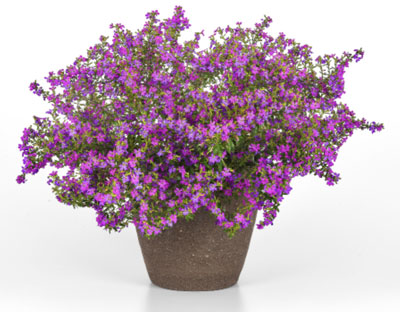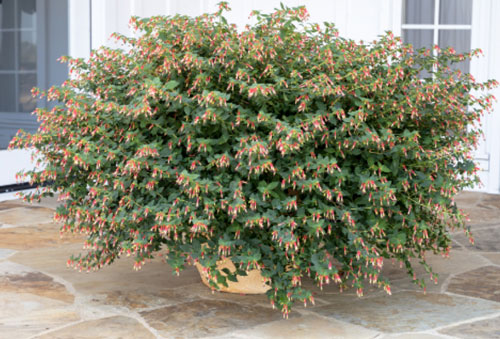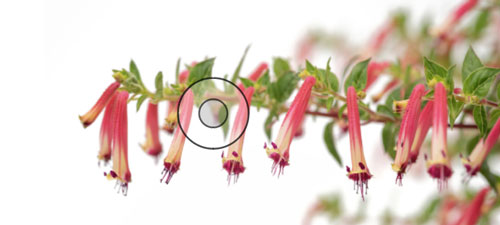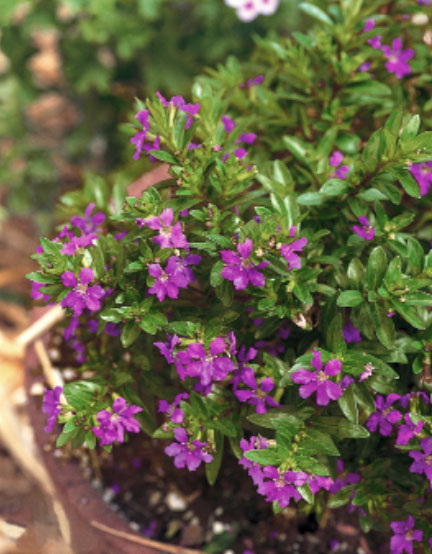4/30/2025
Cupheas Move North
Lowell Halvorson

Cuphea is a deeply Southern favorite loping its way toward greater acceptance by the trade nationally. Sales increases over the past decade aren’t spectacular, but they’re strong enough to see new breeding enter the category lately from both the majors and the minors. That growth can be easy to miss because cuphea is buried deep among the specialty products. Nobody has it on their Top 10 list. Still, that growth is there, especially for firms that can suss out cuphea’s strengths.
The Enchantia series is groomed for production in the channel. That white is especially clean for wedding work.
Commercial accounts form the core of cuphea’s historical revenue base, especially along the Gulf Coast from Texas to Florida. The color is reliable in all forms of heat with one of two different kinds of flowers blooming over the top, depending on the cultivar. Its rugged shrubby nature doesn’t require a lot of water, keeps the soil cool and hugs moisture close to the ground.
Culturally, it works just like the equally rugged lantana. Nationally, more places have seen water restrictions and heat domes over the summer. Cuphea just settles right in and calls it East Texas.
The category comes in two flower forms: Mexican heather and cigar flower. Both types see their best book of business building out beds, but more designers are choosing to incorporate their features into baskets and decor containers. High heat tolerance and cool flowers—plus pollinator power—equal attractive potential for cuphea. Even MixMasters has a plug with a cuphea component: Hot Spell.
Mexican heather
If you squint, you might say the flower resembles a bacopa or maybe a forget-me-not. Perhaps you’ll sense scaevola vibes if your glasses fog up in the greenhouse. Plants tend to cover the soil with about 18 in. of heatherish habit dotted all over by the little flowers.

Big, bad and bold sells Hummingbird’s Lunch. The massive display of thin, tubular flowers attracts the birds and keeps them sipping for a while. Height is about twice the size of Enchantia.
Allyson is the default here, an open variety with decades of established reputation. Default doesn’t mean perfect, however, because this is a first-generation variety. It has its quirks, mostly found in the production cycle. For years this was OK because cupheas were a C-tier specialty product. Now that its growth is shifting up into the B-tier, breeders major and minor are paying more attention to it.
 A good example is the Enchantia series, a second generation improvement introduced to the trade last year. At first glance, it looks like classic Mexican heather, except it comes in three colors: white, lavender and purple. A key improvement is a more consistent habit to the branching around the crown. Allyson is prone to lumpiness, whereas Enchantia mounds in a pot-filling style. This distributes the color more evenly over the top and helps to smooth out bald spots. By pushing the branch count up, Enchantia has a denser show of color (more buds) and blooms earlier for more spring sales.
A good example is the Enchantia series, a second generation improvement introduced to the trade last year. At first glance, it looks like classic Mexican heather, except it comes in three colors: white, lavender and purple. A key improvement is a more consistent habit to the branching around the crown. Allyson is prone to lumpiness, whereas Enchantia mounds in a pot-filling style. This distributes the color more evenly over the top and helps to smooth out bald spots. By pushing the branch count up, Enchantia has a denser show of color (more buds) and blooms earlier for more spring sales.
That mounding habit has a financial ripple. With a more predictable circle of coverage, growers can pull back on the ppp for the crop. Landscapers can squeeze the diamond to create a taller, fluffier bed of color or stretch it to achieve more soil coverage per planting. Consistent mounding means money.
One nice Enchantia touch is the clean white that shows up during the August wedding season. Since the lacy flower style is self-cleaning, the heatherish good looks stay pristine throughout preparations and during the ceremony. Once in bloom, the plant stays that way for a long time provided that it gets water and lots of light. It sits well as a table centerpiece.
Cigar flower
Rather than the tip-end petal flair of the Mexican heathers, cigar flower cupheas have loads of long, skinny tubes. The most widely grown variety is Hummingbird’s Lunch, a second-generation cultivar introduced in 2020 and developed for Sydney’s Australian climate.
The name says it all. A key factor for this cultivar is its strong vigor. To draw lots of hummingbirds, a cuphea needs to set out a big, bad, bold display. Hustling all that nectar up to the blossoms takes a strong plant, especially when lots of feeding stations are needed to make crowds of hummers stick around the garden. Hummingbird’s Lunch grows about 2-ft. tall and widens out to around 3 ft.
Allyson establishes the classic look of Mexican heather.
 Like Mexican heathers, Hummingbird’s Lunch has a strong Southern base of sales, but an interesting detail on this cultivar is the improved cool performance. I happen to know that Sydney’s nights can get cold, so it’s not surprising that Hummingbird’s Lunch stays in flower during the cool spells of autumn. Treated as an annual item, this moves cuphea sales northward into the Ohio River Valley and up the East Coast through the Mid-Atlantic and along coastal New England.
Like Mexican heathers, Hummingbird’s Lunch has a strong Southern base of sales, but an interesting detail on this cultivar is the improved cool performance. I happen to know that Sydney’s nights can get cold, so it’s not surprising that Hummingbird’s Lunch stays in flower during the cool spells of autumn. Treated as an annual item, this moves cuphea sales northward into the Ohio River Valley and up the East Coast through the Mid-Atlantic and along coastal New England.
It even makes a great hummer basket for anyone willing to ship such a product in the North. Hummingbird’s Lunch matures in about the same time frame as other late spring basket items.
Connoisseur cultivar
Then there’s Batface, the category’s OG. It’s been around a long time, falls under a different species, has a great name and, yeah—the flowers look like little bat faces. Among the other cultivars Batface always shows up high in the cuphea rankings. It has a dedicated fanbase, no question: the flowers are so cute, but the plants are hard to grow. It looks like nothing else, but it gets Odema. Plants thrive in the heat, but they don’t branch well. People in the know grow Batface. Like driving an old MG or Triumph, it doesn’t have problems, just personality.
Cuphea sales chug these days. Batface appeals to the avid gardener, whereas Enchantia is a workman’s cuphea with a color job to do and a production schedule to keep. Hummingbird’s Lunch—well, it’s a hummingbird diner. How cool is that? GT
Lowell Halvorson is a consultant and writer in Fairfield, Connecticut, for retail and wholesale horticulture, specializing in business development. He also covers the breeding community for GrowerTalks magazine. You can contact him at (203) 257-9345 or halvorson@triadicon.com.